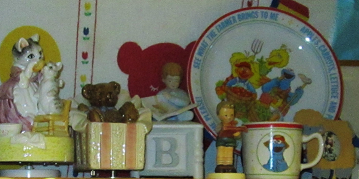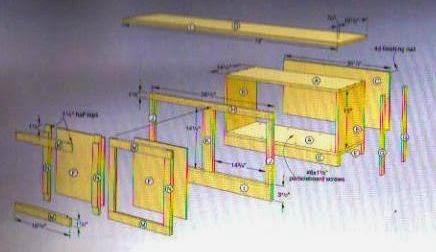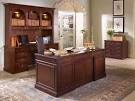Now that I had the basic concept, all I had to do was find the space. Where art thou, space? The kid’s bedrooms were filled to the gills. Not an inch to spare. Hallway too narrow and the guest bedroom/my office had more than enough furniture and bookcases. I was frustrated.
As I sat at my desk and stared our the door, in my view was the lacy white curtains that concealed two wide openings to the linen closet, however, the closet did not have one iota of linen. There was a mattress & box spring, boxes of holiday decorations, construction material, window screens, tools - you get the picture. The closet was quite commodious. It ran the length of the back hall - about fourteen feet. It was four feet deep and nine feet high. Here again, it was an unfinished part of the house. The closet ceiling had a trap door that opened into the attic. We thought of putting the back stairway in this space but it never came to fruition.
 Pulling back the curtains, I took a big sigh and asked myself, “Now what do I do with these things? Where will I put the mattress? Decorations?” All of a sudden, it sadly dawned on me that regardless of the fact my house was large, there was very little storage besides the attic and now that was off the grid. I could put some of the things down in the basement, like the construction stuff, but certainly not the mattress. With my storage options exhausted, I was ready to give up on our family museum.
Pulling back the curtains, I took a big sigh and asked myself, “Now what do I do with these things? Where will I put the mattress? Decorations?” All of a sudden, it sadly dawned on me that regardless of the fact my house was large, there was very little storage besides the attic and now that was off the grid. I could put some of the things down in the basement, like the construction stuff, but certainly not the mattress. With my storage options exhausted, I was ready to give up on our family museum.
As I finished up in the laundry, so conveniently located next to my office – no getting away from that chore – I needed to get out the vacuum cleaner stored in the tiny area behind the laundry room, which housed the dryer hose and vent, plumbing pipes and electrical wiring.
When my husband built our house, all unused space was noted, especially the area under the eaves (the part of a roof that projects beyond the wall that supports it - attic or roof), which is wasted space. Just think about how much of it can be used for storage. Many new and old houses have this space and it can be obtained by putting in a door, laying down some flooring, insulting and lighting it. Voila! Storage space. Maybe not much space, nevertheless, space. After I measured it and installed some simple shelving, I was not only able to move all those Christmas boxes, I had a place to but the mattress and box spring. That freed up the space in the so-called linen closet that now became Our Family Museum. Boy, was I thrilled.
So here I am, staring in front of this empty space - a linen closet 4 ft. wide x 14 ft. long. Two open spaces for double doors and an air vent located in the center of the ceiling. Tan colored linoleum covered the floor. That was doable. The walls were that yucky builders' off-white that had to be changed. But what color? And what kind of doors? We decided standard French doors with windows for viewing and would keep items safe and fairly dust-free. Lighting, which is paramount for display, was already installed. Not desirable, but it would do for now.
Meanwhile, on the floor in the hallway, my office, the bedrooms, even the bathrooms, stacks of boxes held the things I wanted to put into the Family Museum and I hadn't the foggiest idea where to begin. Then a cry of anguish echoed down the hall. My husband Keith stubbed his toes on a stack of boxes, almost knocking them all down. Hobbling over to me, we stood their together starring into the empty closet. Pulling out his tape measure, he sighed, "Well I guess it is time to build the shelves." And so he did . . .
So here I am, staring in front of this empty space - a linen closet 4 ft. wide x 14 ft. long. Two open spaces for double doors and an air vent located in the center of the ceiling. Tan colored linoleum covered the floor. That was doable. The walls were that yucky builders' off-white that had to be changed. But what color? And what kind of doors? We decided standard French doors with windows for viewing and would keep items safe and fairly dust-free. Lighting, which is paramount for display, was already installed. Not desirable, but it would do for now.
Meanwhile, on the floor in the hallway, my office, the bedrooms, even the bathrooms, stacks of boxes held the things I wanted to put into the Family Museum and I hadn't the foggiest idea where to begin. Then a cry of anguish echoed down the hall. My husband Keith stubbed his toes on a stack of boxes, almost knocking them all down. Hobbling over to me, we stood their together starring into the empty closet. Pulling out his tape measure, he sighed, "Well I guess it is time to build the shelves." And so he did . . .
 On the weekends, during the evenings, on days off and then some, Keith built the shelves. Using plywood left over from our house construction, he measured twice, cut once, and created the shelves for our Family Museum.
On the weekends, during the evenings, on days off and then some, Keith built the shelves. Using plywood left over from our house construction, he measured twice, cut once, and created the shelves for our Family Museum.  After he installed all the shelves for both sides; one was for our things, the other side for the kids, I painted the back walls purple and the shelves a creamy white. I made a curtain (I chose a dark color with a little sparkle for an artistic touch) and attached them on a tension rod. Under the large counter I placed some pre-fabricated book shelves, giving me much needed storage space.
After he installed all the shelves for both sides; one was for our things, the other side for the kids, I painted the back walls purple and the shelves a creamy white. I made a curtain (I chose a dark color with a little sparkle for an artistic touch) and attached them on a tension rod. Under the large counter I placed some pre-fabricated book shelves, giving me much needed storage space.Now it was time to select and display the items.
At first it was a daunting job. I wasn't sure where to begin. Then as I was taking things out of the boxes and putting them into distinctive piles - his, mine, ours - I found two items of my husbands that were almost identical to the two items I had when we were babies: a toy and book. I place them in the center, his to the left, mine to the right, which designated the two collections. From there, everything that was mine went on my side and his on the left side. And since the first things were from our childhood, I went with that idea of doing a chronological display. With having four shelves, it was like creating a timeline of our lives displaying the things that we played with, things from our school days, careers, and so on. I could not believe how everything started to fall in place. I will go into more detail about how the things were displayed and the challenges I had in doing so.
After the museum was filled, we installed the doors and Keith did some fancy trim work. Then he made a colorful sign and hung it between the sets of doors. This establish the once lowly linen closet into
Our Family Museum.
Even after having the museum for several years, my family and I still can't believe we have such a place in our home. And when guests come over and we take them to see our museum, they are all surprised and impressed.
Our Family Museum.
Even after having the museum for several years, my family and I still can't believe we have such a place in our home. And when guests come over and we take them to see our museum, they are all surprised and impressed.
They could not believe how wonderful it was to have our family memorabilia, heirlooms, collectables, and other precious items so beautifully displayed as well as safe & secure.
That is what having a Family Museum in your home is all about.
That is what having a Family Museum in your home is all about.
Next Post: Why we celebrate Labor Day















































